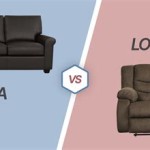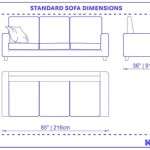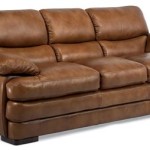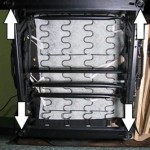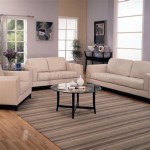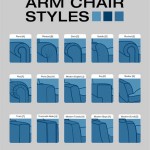Average Dimensions of a Sofa
Sofas, central to living room comfort and design, come in a wide array of sizes and configurations. Understanding standard sofa dimensions can greatly assist in planning room layouts and selecting the perfect sofa to suit specific needs and available space. While variations exist depending on style and manufacturer, general guidelines provide a helpful starting point.
A standard three-cushion sofa, a common choice for many homes, typically measures between 72 and 96 inches in length. This length provides ample seating for three adults comfortably. Depth, measured from the front edge of the seat cushion to the back of the sofa, usually falls between 35 and 40 inches. Overall height, from the floor to the highest point of the sofa back, typically ranges from 30 to 40 inches.
Two-cushion sofas, often referred to as loveseats, are designed for smaller spaces or as complementary seating in larger rooms. These sofas generally measure between 50 and 72 inches in length, maintaining a similar depth and height to their three-cushion counterparts. Loveseats comfortably accommodate two adults.
Sectionals, which offer versatile configurations and ample seating, present more complex dimensional considerations. These sofas comprise multiple independent sections that can be arranged to fit specific room shapes and seating requirements. Individual sections can range in size from small corner units to larger armless units. The overall dimensions of a sectional sofa can vary significantly depending on the number and arrangement of these sections.
Sofa depth is a crucial factor affecting both comfort and space planning. Standard depth, as mentioned previously, is generally between 35 and 40 inches. However, some sofas offer deeper seating, sometimes exceeding 45 inches. These deeper sofas can provide a more relaxed lounging experience but require more floor space. Conversely, apartment-size sofas often feature shallower depths to maximize space in smaller living areas.
Seat height, the distance from the floor to the top of the seat cushion, also contributes significantly to comfort. Standard seat height generally ranges from 17 to 20 inches. This height allows most individuals to sit and stand comfortably. Variations in seat height can accommodate different preferences and physical needs.
Arm height, the distance from the floor to the top of the armrest, typically falls between 24 and 28 inches. Arm height influences both aesthetics and comfort. Lower armrests can provide a more modern look, while higher armrests offer better support for the arms and back.
Back height, measured from the seat cushion to the top of the sofa back, varies considerably depending on the sofa style. Low-back sofas, often featured in contemporary designs, offer a streamlined appearance but may provide less back support. High-back sofas, more common in traditional styles, offer greater back support and a more formal aesthetic.
Beyond these standard sofa types, other variations exist, including chaise lounge sofas, sleeper sofas, and oversized sofas. Chaise lounge sofas incorporate an extended seat section designed for reclining. Sleeper sofas contain a hidden mattress for overnight guests. Oversized sofas, as the name suggests, offer larger dimensions for maximum seating capacity and comfort.
When considering sofa dimensions, it is essential to account for the available space in the room. Careful measurement of the intended sofa location is crucial to ensure a proper fit. Leaving adequate space for walkways and other furniture is essential for maintaining a functional and comfortable living environment.
In addition to physical dimensions, the visual weight of a sofa can impact the overall perception of space. Bulky sofas with large arms and high backs can make a room feel smaller, while sleek sofas with slender profiles can create a sense of spaciousness.
Choosing the right sofa involves carefully considering both functional needs and aesthetic preferences. Understanding standard sofa dimensions and their variations allows for informed decisions, ensuring a comfortable and well-designed living space.
Manufacturers often provide detailed dimension specifications for their sofa models. Consulting these specifications is highly recommended to ensure accurate measurements for planning and purchasing decisions.
The style of a sofa also significantly influences its dimensions. For example, a Chesterfield sofa will typically have a deeper seat and a higher back than a mid-century modern sofa. Considering the style preferences alongside the dimensional requirements allows for a harmonious blend of form and function.
Finally, remember that cushion firmness and material can also affect the perceived comfort and size of a sofa. Testing different sofa models in person, if possible, can provide valuable insights beyond the numerical dimensions and help determine the best fit for individual preferences and needs.

Sofa Dimensions 101 Measuring For Your Perfect

Standard Sofa Dimensions For 2 3 4 And 5 Person Charts Diagrams Styling

Sofa Dimensions For 2 3 4 And 5 Person Couches Charts Diagrams Design Formal Living Room Designs

Nice Standard Sofa Length Elegant 34 For Your Living Room Ideas With Size Cool Couches Furniture Details Design

Sofa Design Ideas Choose Right For Your Living Room
Your Guide To Measuring Sofa Dfs

Importance Of Dimensions When Furniture

Standard Sofa Dimensions For 2 3 4 And 5 Person Charts Diagrams Engineering Discoveries

Sofa Size Calculator

Esquel Sofa Birch Beige Urban Ladder

